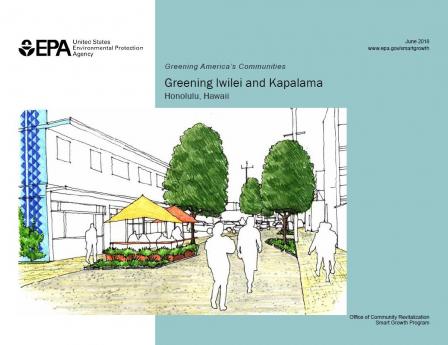 Many areas of Honolulu, Hawaii, including the Iwilei and Kapalama neighborhoods, will be transformed as a new rail line is built and surrounding development responds to rezoning and transit-oriented development policies. Iwilei and Kapalama are legacy mixed-use communities in Honolulu’s industrial core and are challenged by poor street connectivity, a lack of sidewalks and bike lanes, localized flooding, and susceptibility to sea level rise.
Many areas of Honolulu, Hawaii, including the Iwilei and Kapalama neighborhoods, will be transformed as a new rail line is built and surrounding development responds to rezoning and transit-oriented development policies. Iwilei and Kapalama are legacy mixed-use communities in Honolulu’s industrial core and are challenged by poor street connectivity, a lack of sidewalks and bike lanes, localized flooding, and susceptibility to sea level rise.
The city and county of Honolulu requested technical assistance through EPA’s Greening America’s Communities Program to help imagine potential designs and strategies for more innovative, environmentally friendly streets and neighborhoods.
The designs presented in this report are intended to help Honolulu achieve multiple community benefits as Iwilei and Kapalama redevelop. The designs include approaches that:
- Support economic development and public investment in transit.
- Address current and future disaster risk.
- Promote public art and placemaking.
- Better manage stormwater with green infrastructure.
- Create streets that are safe, accessible, and usable by people of all abilities who are walking, taking transit, biking, or driving around the neighborhood.
This report includes a discussion of project goals, challenges, and opportunities identified during the three-day workshop in Honolulu; a project area assessment of existing conditions in Iwilei and Kapalama; and a set of design options for select locations in Iwilei and Kapalama.
The final chapter, Next Steps and Funding, presents ideas about how to pay for and implement the designs, and possible actions that could catalyze improvements not only in Iwilei and Kapalama, but in other parts of Honolulu as well. An appendix features relevant case studies and shows how other communities addressed issues similar to those in Iwilei and Kapalama.
You may need a PDF reader to view some of the files on this page. See EPA’s About PDF page to learn more.- Greening America's Communities: Honolulu, Hawaii (PDF)(50 pp, 3 MB, 2018)
